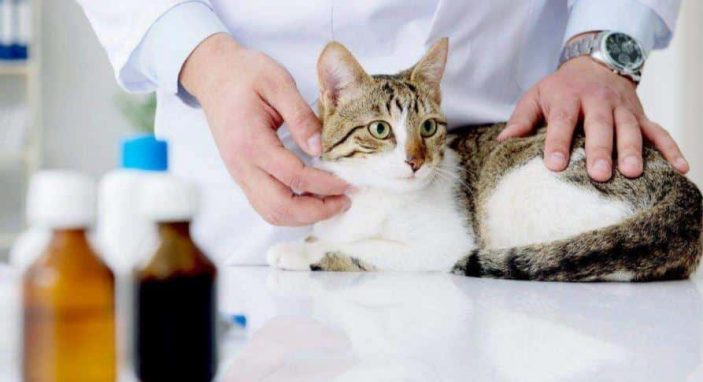Calcium is one of the vital minerals that cat’s need. It forms part of this pet’s teeth, bones, and cartilage, It also helps in blood clotting, muscle contraction, heartbeat regulation, nerve impulse, among others.
In a cat’s body, 99% of calcium is stored in bones while the remaining 1% forms part of the extracellular fluid such as the interstitial fluid and blood plasma.
According to Vet stream.com, “the total calcium is composed of 50% ionized calcium (iCa), 40% protein-bound (pCa) and 10% in complexed” with the iCa (also free ion) the biologically active part.
Cats must regulate the amount iCa in their body. Low serum amounts will lead to hypocalcemia where symptoms will start showing when total calcium levels go below 6.7mg/dL.
On the other hand, a high amount, usually in excess of 10.5mg/dL (or over 5.5mg/dL ionized calcium) will result in hypercalcemia.
Symptoms
Whereas hypercalcemia can be toxic to various body tissues, usually, the kidneys, cardiovascular and nervous system suffers most deleterious effects. Some of the symptoms noted include:
- Polyuria and polydipsia – excessive urination and thirst respectively
- Lethargy
- Weakness, lethargy, fatigue or lack of energy
- Anorexia
- A swollen neck due to enlargement of lymph nodes especially if associated with lymphosarcoma
- Confusion or disorientation
- Depression
- Constipation
- A decrease in gut function
- Kidney and bladder stones
- An increase in blood pressure
- Unconsciousness that may be followed by a comma
- Changes in a heartbeat rhythm.
If the amount is too high, soft tissue calcification may also be noted.
High calcium level in cats causes
For causes of elevated calcium levels in cats to be well understood, understanding calcium homeostasis is vital, although it is a complex process.
How it occurs could be to be via interaction of parathyroid hormone (PTH) and vitamin D3 or calcitriol. When serum iCa goes down, the parathyroid glands will detect it, stimulate the PTH hormone that will activate calcitriol whose level will rise.
Calcitriol increases intestinal calcium absorption, reduces dumping by the kidney and helps in its release from the bones while PHT mobilizes it via bone resorption both with phosphate but make the kidney to damp more phosphate while it retains calcium. The dumping of phosphate helps avoid hyperphosphatemia.
As calcitriol levels go high, it reaches a point where it stops PTH hormone production and the iCa will begin decreasing again.
High calcium in cats causes results when this interaction is interfered with or due to idiopathic hypercalcemia (which is the most commonly noted and its cause not known).
Some of the known causes include:
- Parathyroid gland malfunction
- Primary hyperthyroidism – overactive parathyroid glands
- High calcium levels in cats can be due to cancers or tumors, leukemia, multiple myeloma, squamous cell carcinoma, parathyroid gland adenocarcinoma, or if the tumor spreads to bones.
- The Journal of Veterinary Internal Medicine notes that chronic kidney failure is likely to cause hypercalcemia. Acute kidney failure will also have the same impact.
- Addison’s disease or underactive adrenal glands that result in hypoadrenocorticism is another cause.
- Poisoning from vitamin D (including excessive amounts, by cholecalciferol rodent poison or some plants) or toxicity from some calcium supplements.
- Aluminum toxicity
- Inflammatory conditions such as granulomatous or bone diseases such as osteolysis.
To remember causes easily consider the mnemonic “HARDIONS G; Hyperparathyroidism, Addison’s disease, Renal disease, Vitamin D Toxicity, Idiopathic/Iatrogenic, Osteolytic disease, Neoplasia, Spurious and Granulomatous (i.e fungal) disease,” notes the Central Toronto Veterinary Referral Clinic.
Diagnosis
It will involve physical examination, performing a complete blood count (CBC), urinalysis, chemistry panel, blood biochemistry profile, ultrasounds, and radiographs. Also, you need to ensure that the elevated iCa levels are persistent.

Blood biochemistry profile will show total calcium content but conducting checking on ionized level or iCa (biologically active form) content will give you a more definitive answer since dehydration and some diets may make the total amount to be high.
Also, a parathyroid hormone level and parathyroid hormone-related protein level (PTH-Related Peptide) in the case of hyperthyroidism will range from normal to high while in case of malignancy, the related hormone proteins will much be elevated. However, these two will be low in case of idiopathic hypercalcemia, notes Pet Health Network.
Radiographs and ultrasound will detect underlying causes such as bladder stones, cancer, kidney and kidney stones.
A chemistry panel will study if the liver and kidney are functioning well while urinalysis shows the presence of crystals, infections, urine concentration, etc.
Moreover, your vet may recommend “ELISA tests for feline leukemia virus (FeLV) and feline immunodeficiency virus (FIV)” notes DMV 360.
Finally, your vet may collect liquids from bone marrow or lymph nodes (lymph node aspirate) if he or she suspects lymphoma as well as checking vitamin D concentration.
Treatment
In case the diagnostic blood test results show high calcium levels, hospitalization may be recommended. Afterward, there will be fluid therapy (diuretics) and the underlying cause will be treated.
The treatment approach will depend on the underlying cause, chemotherapy may be considered in case of cancer, medications to alter the absorption of calcium, bisphosphonates to reduce its release by bones, and so on.
Furthermore, your vet may recommend you go for low calcium foods or diets, wet foods, or high fiber diets if you use acidifying diets.
Prevention
Go for follow-up checkup after treatment to see if the problem completely resolved and ensure the biochemistry profile is conducted.
